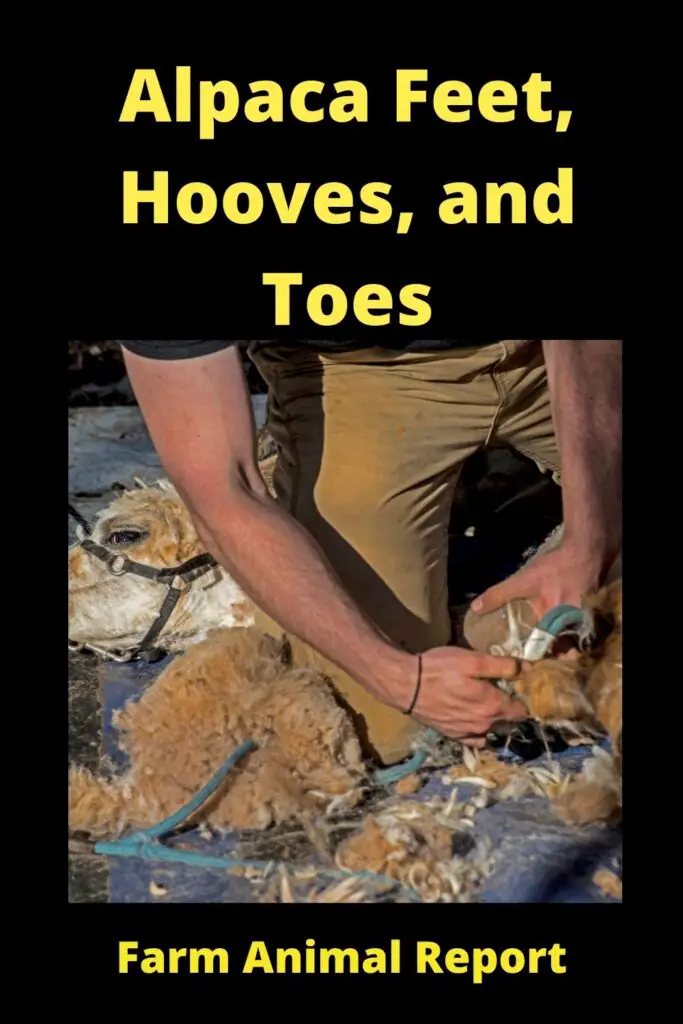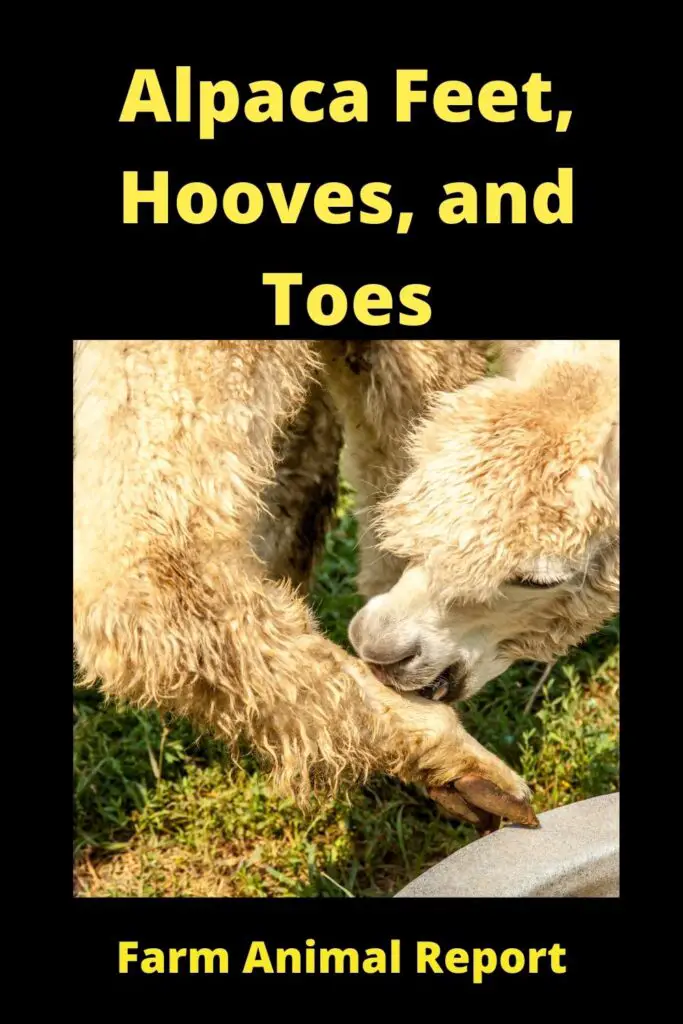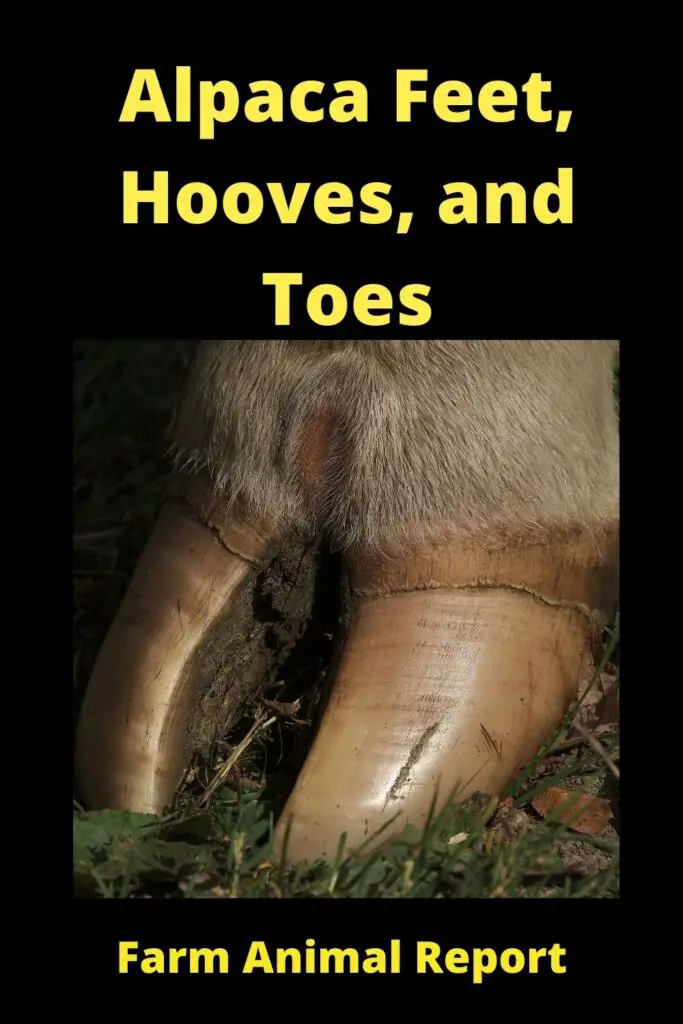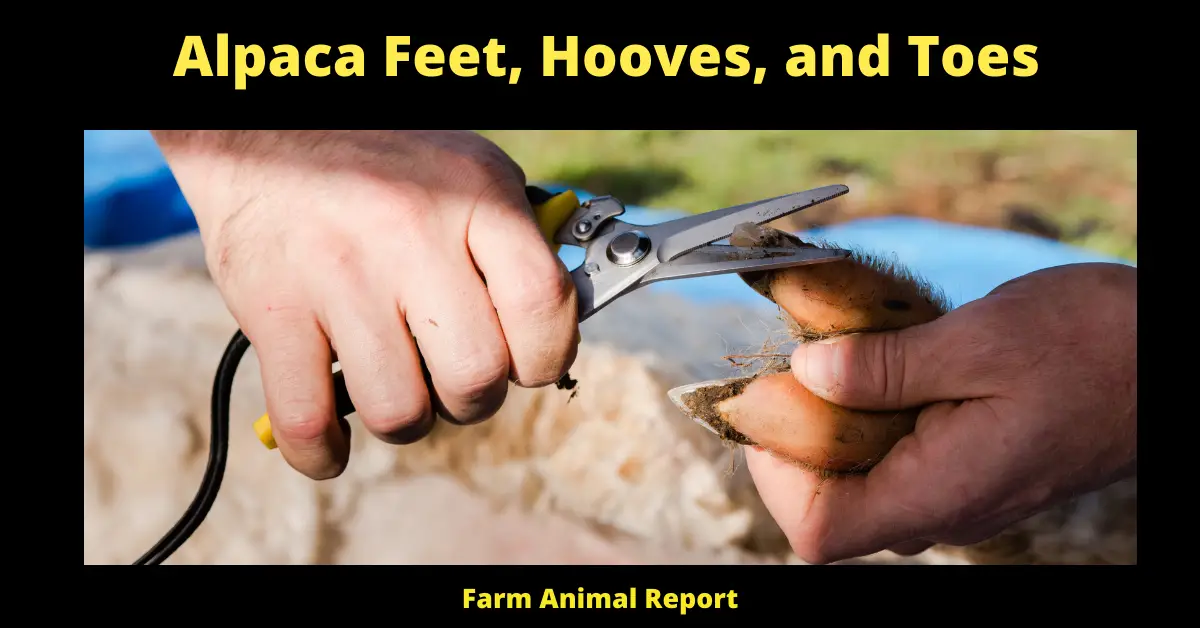Alpaca Hooves – As a general rule Alpacas and llamas are limited to walking speeds no more significant than 2 mph (3.2 kph) because they have only three digits to support their weight while walking, forcing them to adopt a weird gait called the “posting trot,” where they put one foot in front of the other, almost like walking. Their toes need to be trimmed on a regular basis.
Alpaca Hooves – Do Alpacas Have Hooves?
Alpacas and llamas are often found together in pastures, but they’re different species. Alpacas are only found naturally in South America, while llamas can be seen as far north as Canada and south as Chile.
Typically, alpacas weigh about 150 to 200 pounds and grow to a height of about 34 inches. Llamas can be about twice that size at roughly 350 pounds and up to 39 inches in height. Alpacas have shorter, thicker necks, while llamas have longer, slenderer necks. Do Alpacas Have Hooves?
Check Out Amazon’s Educational Resources for Raising Alpacas
Alpacas are well known for their luxurious fleece. Their fiber has been likened to cashmere in softness and is often used by yarn spinners to make commercial yarns. But did you know that alpacas have four “toes” on each foot?
Each toe is called a digit, which is equivalent to the human finger or toe. The term “ungulate,” a class of animals with hooves, includes alpacas and llamas. Llamas have three digits on each foot, while alpacas have four.
An ungulate’s number of digits plays an essential role in the animal’s movement and survival. A good example is our species. The horse is a classic example of an ungulate that has only a single toe/digit on each foot, and it can run at speeds up to 30 mph (48 kph).
People, like other primates, walk with our weight supported in the middle of our foot by all digits (five for humans), allowing us to walk at a speed of about three mph (4.8 kph).

Alpaca Feet – Alpacas and llamas are limited to walking speeds no more significant than two mph (3.2 kph) because they have only three digits to support their weight while walking, forcing them to adopt a weird gait called the “posting trot,” where they put one foot in front of the other, almost like walking.
Alpacas and llamas are built differently than horses to accommodate this type of gait, where they can also go surprisingly fast for their size. For instance, the highest speed recorded for an alpaca is about 30 mph (48 kph).
Alpacas and llamas rely on their carpal (knee) joints to absorb the shock of repeated footfalls when they walk, much like humans use our knee joints. Humans also rely on having an odd number of digits (two), while Alpacas and llamas have four digits on each leg.
Alpacas’ feet are wider at the bottom than at the top, which provides a larger surface area for support. This is important to alpacas because alpaca owners must care adequately for their feet if they want their animals to remain sound and comfortable.
For example, many breeds of dogs have pads between their toes to prevent them from sinking into snow when they walk – this is why you don’t see dogs tracking snow into your home. Many breeds also have dewclaws, which are a digit above the one of their foot – these digits do not touch the ground and cannot be used to support the dog’s weight.
What are the Parts of The Alpaca Foot? (Alpaca Foot Stock)
Alpacas are well-known for their friendly and gentle dispositions; they can make great pets. But do you know what’s in an alpaca foot? The feet of the alpaca, like those of other camelids such as camels and llamas, the feet of the alpaca consist of three toes with a tough alpaca pad on which they walk. The center toe is the largest, with two toes flanking it on each side.
The top part of an alpaca foot is called a pastern, and it contains five bones, similar to horses. The bottom part is called a hoof and has a thick exterior wall in the shape of a horseshoe or half-circle, used to protect the soft tissue and bones inside the foot.
The bottom of an alpaca’s hoof is padded with a rubbery, gelatinous material called a frog that acts as a shock absorber. Between each toe and its corresponding Pad, there is a tuft of coarse hair called a dewclaw. Dewclaws are vestigial toe, and they are not used for walking.
In the wild, alpacas walk on dry grasslands. In captivity, they may be more inclined to wear down their hooves due to being cooped up in stalls or on hard surfaces. It is essential to keep track of your alpaca’s weight and monitor their foot health.

Alpacas that become overweight may suffer from laminitis, which is sometimes referred to as a founder. The founder is a severe and often fatal disease, where the soft tissues inside the hoof start to die because of a lack of blood supply, making it difficult for alpacas to walk to not create painful walking conditions.
So to prevent your alpacas from developing laminitis, make sure they are in good health by providing them with a nutritious diet and allowing them access to pasture or dirt where they can dig their toes in.
18 ways Alpaca Farmers make Money
What are Alpaca Feet Called?
Alpaca feet are known as ‘swamp boots,’ which refers to how they can walk through boggy areas without sinking into the mud. They’re built for walking in rugged terrain and have a callous exterior, allowing them to take on heavyweights. However, because of their dense fibers, an alpaca’s feet are also hot and comfortable.
Alpaca feet are known as ‘swamp boots,’ which refers to how they can walk through boggy areas without sinking into the mud. They’re built for walking in difficult terrain and have a callous exterior, allowing them to lift heavyweights. However, because of their dense fibers, an alpaca’s feet are also hot and comfortable.
Why do llamas / Alpacas have Padded Feet?
Llamas and alpacas are domesticated species of South American camelid. They have been bred as livestock by Andean people for thousands of years. Llamas are one of the few domestic animals that run around barefoot. They have two padded feet, with four toes on each foot.
The pads are made up of very thick skin with a large surface area. This protects the llama’s feet from sharp objects they may step on while walking.
The padded feet of llamas and alpacas contain an interdigital gland or ‘foot odor pouch,’ which produces chemicals to help the animals maintain the health of their feet.
The padded sole helps prevent injury when walking on rocky ground and reduces heat stress from repeated impacts during running or strenuous activity in hot climates. This Pad also absorbs shock when the animal walks, especially over rocky terrain.
Like human skin (but more like calluses), the footpad is constantly growing, and one of the ways it sheds itself is by peeling off. The bottom of the footpad also secretes a waxy substance that protects it from being wet and adds to its toughness. This is why even though llamas (and alpacas) will walk through streams and puddles, the pads of their feet stay dry.
These pads protect the feet from rocks, sticks, cactus spines, etc., but they are not indestructible. Llamas, alpacas, and other camelids can step on sharp objects or spines that penetrate the footpad or cut through to the flesh below. This is why it is essential to ensure your llama does not have cactus spines stuck in its feet.
Alpaca Hooves – Trim Alpaca Toenails
Alpacas and llamas have a “soft spot” on their feet just like humans do. This is called an alpaca enclosure of alveolus (plural alveoli). The alveoli of the alpaca enclose the alpaca hooves at birth and harden as they grow up so that they can support the alpaca’s weight.
These alveoli start hardening once the alpacas are about six months old, but for alpacas born with weak alveoli, it takes longer to build them up. The alpaca enclosure of alveolus is one reason why alpacas and llamas should not be castrated.
Alpaca Toes – Toe Nail Trimming
Alpacas are related to camels, but they are smaller than their distant cousins. Their front feet each have two toes, while their back feet have three toes. They also have a thick coat on their feet to protect them from the cold alpaca toes.
Alpacas have been domesticated for over five thousand years; they were first used for their wool, spun into yarn, and then woven into textiles. They have still used for this purpose today alpaca toes.
Alpaca Toenails – Toenail Trimming
Alpaca Toenails are the nails on the toes of an Alpaca. They are similar to human toenails, except they have no quick (the living part of the nail underneath the skin). Alpacas Toenails can grow long enough to curl and may need to be nails trimmed.
Alpaca’s nails can grow up to two inches long. This presents problems for the alpaca since it can interfere with walking and make alpacas clumsy. Trim alpaca toenails for the comfort of alpacas and alpaca owners alike.
Alpacas get their name from the way they walk: rather than “walk,” alpacas move at a gentle pace that some alpaca owners have compared to a sort of “shuffle.” Trim alpaca toenails to help them grip the ground and move more quickly.
Alpacas are gentle creatures, and alpaca owners find it essential to keep alpacas and toenail trimming of alpaca to prevent from injuring themselves.
Do Alpacas need their Feet Trimmed? Trimming | Nails
Alpacas are tough and resilient to such an extent that they will often walk around with very long toenails until they break. Once this happens, it is essential to take the animal to a local veterinarian or farrier to cut the alpaca’s nails. If left unattended to the alpaca will limp, and this is a sign of difficulty.
To prevent injury during everyday activities or while working in the field, it is essential to trim toenails regularly. In actuality, if you don’t get your alpaca’s feet cut, they will get sick and die from being overweight.
The older an alpaca gets, the faster it will walk. The quicker an alpaca walks, the more times it will put its feet down, causing breakage. The sole of its foot supports an animal’s weight. When this breaks down, it can not support itself properly and becomes susceptible to injury.
When an alpaca is getting older and less active, regular nail trimming can become a problem because of lack of movement causing the alpaca’s nails to grow even faster than usual. In these cases, feet should be trimmed when the alpaca is young to have time to get used to the process and not become a problem for you later in life.
How Often do you Trim Alpacas Feet?
This depends on the surface that they walk on and how fast their feet grow. The faster they grow, the more often you would need to trim them. It is essential to have regular trimming done for your alpacas to prevent such things from occurring. Most people recommend that it be done every 6 to 8 weeks.
The most important thing about all four feet is that they are healthy. If your animal has healthy feet, then it can live a long and happy life with you. Healthy feet come from good nutrition, exercise, and vaccinating against clostridial diseases (blackleg) and foot rot.
Trimming of feet is necessary but not as important as those factors mentioned above. The more you trim your alpaca’s feet, the better they will handle on any surface. Trimming also keeps nails from growing into the bottom of the foot and helps prevent tissue bruising under the toenails.
Why is it Essential to Trim Alpaca Feet?
Like any other animal, Alpacas keep their hooves clean by walking around and kicking dirt or sand on them to keep them dry. Some animals, such as horses, also use water for this purpose. If an alpaca can’t walk around because of a pasture situation of confinement, you will need to provide the necessary care so the feet stay healthy.
Muddy pasture conditions can lead to foot rot and other infections. It takes only two weeks without proper care for an animal’s feet to become infected. Alpaca foot maintenance is essential not only for the health of the animals but also for their well-being because comfortable feet make happy camper alpacas.
If you are not familiar with trimming alpaca feet, you will need to learn how to do this and get the necessary tools. Alpacas have two main types of feet: comfy, soft feet, and hard hoofs. The animals with hard claws require more extensive care than those with cushy foot because they grow faster and form cracks, leading to infections. The cushy footed alpacas are easier to maintain because they don’t need that much attention. If an animal has had only one of its feet trimmed, it is tough to walk without making loud noises with the other three sets of hoofs.
Alpaca’s hooves should be trimmed every six weeks unless they are in mud constantly because the feet will crack if kept untrimmed for that long. The first thing you need to do is purchase a good set of trimmers, which can be found online or at farm stores.
It would help if you had several pairs of trimmers, so they don’t have to sit around cluttering your barn until it’s time for new trim. Ensure the blades are sharp and inspect them regularly for damage because a dull blade can tear the animal’s hoof.
How to Trim Alpaca Hooves?
If your alpaca is not trimmed, you will want to do so. Alpacas need their hooves properly trimmed every one-two months to keep the soles of the feet clean and sound. Overgrown nails can lead to overgrowth, which can leave the foot susceptible to infection. Hoof trimming is done with a toenail trimmer. If you don’t want to hire a professional, keep reading for tips on trimming your alpaca’s hooves yourself.
Tools Needed
- Hoof Pick (to clean out dirt and rocks that can get stuck between the toes)
- Clippers (the more blades, the better)
- Abrasive Pad (coarse)
- Nail File (coarse)
- Dremel Tool with a sanding drum and polishing wheel (optional if you do not want to use a grinder tool like this, you can buy a metal file and use that instead)
- Goggles
- Protective Gloves (to protect your hands from the sharp edges of the clipper blade)
- Safety Glasses (if using a Dremel Tool with a grinder wheel)
- Lubricant (WD-40 or equivalent)
- Disposable Diapers (optional but recommended, you can cut the diaper into thin strips for easy application)
- Chux Pads (or a plastic drop sheet to work on top of, and old towel will do in a pinch)
- Clipper Oil (if using an electrical clipper)
- Alcohol (optional but recommended, used to clean blades before and after use)
- Dremel Tool with a sanding drum and polishing wheel (optional if you do not want to use a grinder tool like this, you can buy a metal file and use that instead)
How do you cut an Alpaca’s Toes? Illustrations
The first thing that happens when an alpaca produces a new litter of babies is the emergence of tiny little brown toes. Most people don’t know it, but those little brown toes contain keratin (the same stuff as fingernails), and they should be trimmed with sharp scissors to keep them from curling under and growing into the sole.
Trimming alpaca toes seems like a daunting task, but if you follow these simple steps, the first time should be a snap, and your first trim should take less than five minutes.
- Locate the toenail joint (see diagram).
- Using sharp scissors, carefully cut at an angle toward the center of the toe.
- Continue toenail trimming until the toenail pops out of its socket.
- You may need to cut slightly around the outside of the toe to pop it out entirely but be very careful not to cut too deeply into the flesh.
- If any tissue is attached to the toenail, you can just let it fall off. It’s no big deal.
- With a bit of practice and light pressure, your first cut should take less than five minutes, and subsequent cuts will only take two or three minutes per foot!
- Be sure not to trim too much—alpaca should have slightly long toenails than for them to be cut too short and bleed
- Toenails increase and should be trimmed every two weeks during the spring and summer months (less often in the fall).
What Foot / Hoove problems do Alpacas Have?
A foot problem is one of the most common reasons for an alpaca to be taken to a veterinarian. They are solid and sturdy animals, but any hoof – even their weight resting on it all day or night – can cause lameness.
Alpacas require routine hoof care if they do not live in soft sand and dirt areas. They need to be picked out every day, and the feet checked for any problems such as stones, thorns, or cuts. Feet should also be trimmed quarterly.
If necessary, trimming can be done by a veterinarian but is best performed by the alpaca owner. Light shears should be used to clip away excess growth from their flat-soled feet.
Routine hoof care is essential to your alpaca’s health and comfort, as well as the safety of his handlers.

Symptoms
Alpaca hooves are similar to horse hooves, but they do not grow as fast or as long. For the most part, the condition of an alpaca’s feet will depend on its being kept.
Alpacas can damage their feet if they wear them down over hard surfaces, such as concrete. If the alpacas are not on a natural feeling, it is recommended to provide bedding, so they do not have to stand directly on the ground all day long. It is also essential to know what is happening in their environment or pasture.
Treatment & Prevention
It is essential to distinguish between fungal and bacterial infections in the hoof. More than 90 percent of all reported alpaca hoof problems are caused by a bacterial infection that can be successfully treated if caught early. On the other hand, Fungal infections are much more difficult to treat and often require chemotherapy, which may destroy part of the hoof and result in permanent damage.
The first step is to avoid damage, such as punctures or slices that might let bacteria into the corium (the sensitive tissue under the horny outer layer of skin). Anything that will penetrate the skin has a chance of invading the corium and entering the bloodstream. The best protection against injury is to wear shoes.
Any injury that doesn’t go into the corium will heal like any other skin abrasion. This requires proper cleaning and topical antibiotics such as neomycin sulfate, triple antibiotic ointment, bacitracin zinc, or methenamine hippurate (directions below). Fusidic acid (a standard veterinary prescription) can also prevent infection in minor abrasions but is not used in open wounds.
Final Thoughts -Alpaca Feet
Alpacas have different types of feet from sheep, goats, and even llamas. Their ability to walk on rocky terrain is mainly due to the unique design of their hooves. Shearing is also essential for alpaca hooves. If an alpaca is not shorn regularly, its feet will become prolonged, and the animal could be in pain. If your alpaca’s claws get too long, he can also lose his footing and not be able to walk correctly.
Alpacas will naturally wear down their toenails by walking on rough or rocky terrain, but their hooves will grow too long if they are kept exclusively on soft ground. You should regularly check your alpaca’s feet to ensure they are healthy and the nails are not growing into the footpad.





